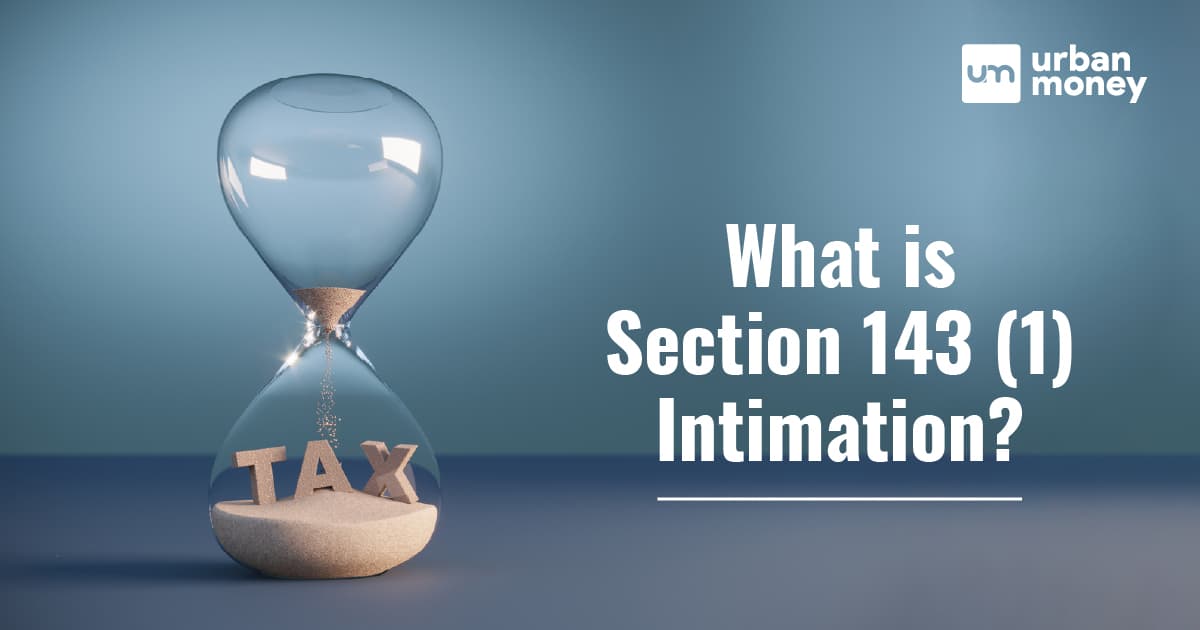- Home
- Income Tax
- Act Under Section 143 1
Section 143 (1) - Income Tax Act

- Personalized solutions
- Expert guidance
- Application assistance
- Credit score discussion
- Interest rate comparison


Last Updated: 15 December 2025
The Centralized Processing Center processes all of the taxpayers’ income tax returns (CPC). Once the processing of the income tax return is completed, the income tax department notifies the taxpayers of the outcomes pursuant to section 143(1) – Income Tax Act.
The CPC system generates the notification of Section 143(1) intimation which typically shows evident problems found by the mainframe system in the filed tax return.
What is Section 143(1) intimation?
In every financial year, everyone who has taxable income is required to submit an income tax return. The Income Tax Department will process the return and check for problems when the taxpayer files his or her taxes. In the event that there are small mistakes on the income tax returns, a summary assessment may be made in accordance with Section 143(1) of Income Tax Act without contacting the assessee. In addition, the assessee receives a Letter of Intimation or Income Tax Notice from the IT Department in accordance with Section 143 of the Income Tax Act. If a taxpayer receives this notification, he or she should make an effort to comprehend it and abide by the Tax Officer’s requirements.
Let’s dive deeper into the details of Section 143 (1) of income tax in this article.
Why is the Intimation u/s 143(1) Issued?
The intimation of Section 143(1) is issued to a taxpayer for the reasons mentioned below:
- If the taxpayer overpays his/her taxes, a tax return amount will be mentioned in the message. The taxpayer will receive a refund if the amount is greater than Rs. 100. Refunds with amounts less than Rs. 100 won’t be given out.
- The notification will state the amount of tax payable by the concerned taxpayer and include a challan for the same payment if the taxpayer has paid taxes that, after computation, are discovered to be short.
- A straightforward statement that the assessing officer’s calculations and the taxpayer’s tax filings are consistent. In certain situations, the assessee does not get a formal notification and should instead consider the ITR V acknowledgment of submitting an income tax return to be the notification.
How Much Time Does One Have to Assess a Section 143 (1) Intimation?
Within a year of the conclusion of the financial year in which the income tax return is filed, a taxpayer may assess a Section 143(1) of income tax notice. The deadline for receiving a letter of notification is March 31, 2022.
For instance, if a taxpayer has filed returns for the years 2020–21. If the assessee doesn’t get a notice before the deadline, there aren’t any modifications the taxpayer needs to make.
What Are the Types of Errors That Come Under Section 143 (1) Of the Income Tax Act?
Once the computerised verification of the submitted income tax return is done, an Income Tax Notice will be issued under Section 143(1) of income tax in any of the following circumstances:
- Any arithmetic error.
- Incorrectly submitted claim.
- Rejection of the loss which has been claimed.
- Rejection of an expense that was reported in the audit report but was missed out while calculating total income.
- Deductions under Sections 10AA, 80-IAB, 80-IE, 80-ID, and/or 80-IC that are rejected because the ITR was submitted beyond the deadline stated in Section 139(1).
- Addition of revenue from Forms 26AS, 16A, or 16 that has not been considered when determining the return’s total income.
- Information that differs from another entry of the same or another return.
- Information necessary to back up an entry or claim has not been given.
- If a deduction is greater than the allowed amount.
How to Respond to Income Tax Notice Under Section 143 (1) Of Income Tax Act?
It is best to double-check the notice’s applicability to your return and the accuracy of the information when you receive the letter of notification. You need to look for mistakes in your ITR after making sure it applies to you and your most recent return. A new return can be filed to correct these mistakes. In order to file an amended return, sign in to the official website for income tax e-filing.
If you disagree with the modifications suggested by the computer system, you may ask for an online correction under Section 154(1).
Process of Responding to the Income Tax Section 143(1) Intimation:
It is crucial that you reply to the income tax notice. According to Section 143(1) of Income Tax Act, your ITR won’t be processed until you’ve made the modifications specified in the letter of notification.
Here is how to reply to an income tax notice in accordance with Section 143 of the Income Tax Act:
Step 1: Access your account by logging in on the Income Tax Department’s official e-filing website.
Step 2: Select the e-assessment by selecting the “E-Proceedings” tab.
Step 3: Navigate to Section 143(1), Prima Facie Adjustment.(a)
Step 4: The information from the Income Tax Notice is shown here. To begin the sharing of a response, click the “Submit” button.
Step 5: The website will provide you with a list of any mismatches found by the automated system when you click “Submit.” To submit a response, select “Response” from the drop-down menu that appears.
Step 6: Include any specific justification for a mismatch in the remarks box if you have one.
Step 7: Prior to submitting your response, share any supporting materials in relation to the inconsistent entries.
Step 8: Simply press the “Submit” button. You will get an acknowledgement after the response has been properly submitted.
What if No Intimation is Received till the Expiry of One Year?
If the taxpayer doesn’t receive the intimation until the expiry of the financial year the return was filed in, it simply means that there is no amount due from or refundable to the taxpayer; no adjustment has been made and the acknowledgement of the return will be taken as the notification.
What is the Password to Open Intimation u/s 143(1)?
The notice provided in accordance with Section 143(1) is password-protected. Your PAN (in lowercase) followed by your D.O.B. in the format DD/MM/YYYY, with no spaces, will serve as the ITR notification password.
Example
The password to open the notification will be “rstuv5678x02021994,” assuming that the PAN is RSTUV5678X and your date of birth is 02/02/1994.
How to Contact the Income Tax Department?
When it comes to helping people with their questions or finding solutions, the income tax department’s customer care division excels. Any of the above numbers can be called at any time by people who need assistance.
The Income Tax Department provides contact centre services to help taxpayers more easily find answers to their questions. Taxpayers can call these customer service numbers with questions about e-filing their returns, to get help with login issues on the e-filing website, to get their income tax information, such as their TAN and PAN, to learn more about Form 16 and Form 26AS, etc. The customer service lines are shown below, and you can call them to get help:
- For general inquiries about income tax, TAN, and PAN, contact the Aaykar Sampark Kendra at 1800-180-1961 (toll free). Monday through Saturday, this facility is open from 8 AM to 8 PM.
- For questions about e-filing returns and login issues on the website, dial 1800-103-0025 (toll free) or 080-46122000 (helpdesk). This facility is open Monday through Saturday from 9 AM to 8 PM.
- For questions about notice, reimbursement, processing, and rectification of your income tax returns, call the helpline at 080-46605200 or the toll-free number at 1800-103-4455. On Monday through Friday, this facility is open from 8 AM to 8 PM.
- For questions about TRACES (TDS Centralised Processing Centre), Form 16, Form 15CA, Form 26AS, and TDS statement, dial 120-4814600 (Helpline) or 1800-103-0344 (Toll free). This facility is open from Monday through Saturday from 10 AM to 6 PM.
- For questions regarding TAN and PAN applications for update/issuance via NSDL, call the helpline at 020-27218080. Every day of the week, from 7 AM to 11 PM, this facility is open.
How to get the Intimation u/s143(1) if you haven’t Received the Mail?
If you have not gotten your notification on your registered mail ID or if you cannot locate that mail, you can re-receive your notification in accordance with Section 143(1) by taking the following actions:-
Step 1: Open the official tax filing portal and login to your account by filling in your credentials.
Step 2: On the dashboard, tap on the option of ‘e-file’, select the option of ‘Income Tax Returns’, and then select ‘View Filed Returns’ option.
Step 3: On the new page you can now see the filed returns and download the intimation order.
What Are the Recent Amendments to Section 143(1)?
The government has made the below mentioned amendments to Section 143(1):
- According to section 143(1)(a), after applying the adjustments outlined in clauses (i) through (vi), the total income (or loss) shall be estimated at the time the return of income is processed. The aforementioned clause’s subclause (vi) allows for adjustments to be made in light of additional income reported on Forms 26AS, 16A, or 16 but not taken into account when determining the return’s total income. This section has been changed to (since the year 2018–19), no adjustment under sub clause (vi) would be made in relation to any returns that have been submitted.
- By removing the point of contact between the Assessee and the Assessing officer, making the best use of the available resources, and implementing an assessment which is team-based, a new assessment scheme has been developed to promote greater openness and accountability. With effect from April 1, 2018, a new sub-section (3A) has been added to the law with the intent of allowing the government to specify the above mentioned new scheme for inquiry assessments by publication in the Official Gazette. Additionally, sub-section (3B) has been added, giving the Central Government the authority to order (by publication in the Official Gazette) that any legislation relating to assessment be applied with the exceptions, changes, and adaptations mentioned therein, or not at all.
Frequently Asked Questions (FAQs)
What do I do if intimation u/s 143 (1) is received?
If one receives the intimation u/s 143 (1) then the individual has to verify all the details and the tax liability and then pay the tax demanded.
What is CPC intimation under section 143 (1)?
The CPC intimation u/s 143(1) is a summary of the information you provided to the tax department and the information the department took into account when processing your return.
Do I need to file a revised return after intimation u/s 143 (1)?
After the taxpayer has received the notice of intimation under Section 143(1) from the Income Tax Department, it is entirely permissible to file a revised return. In accordance with Section 139(5) of the Income Tax Act, the updated return may be filed.
How do you respond to 143 (1) notice?
One should verify all the corrections demanded and then file a revised return before the deadline.
What is the time limit for 143 (1)?
The time limit to respond for u/s 143(1) is the end of the financial year the return was filed in.
How long does it take to get a refund after 143 (1)?
If the taxpayer’s return is accepted as valid and contains a refund claim, the taxpayer will receive their refund. From the date of the income tax return’s e-verification, the credit of refund procedure normally takes 20 to 45 days to complete.
